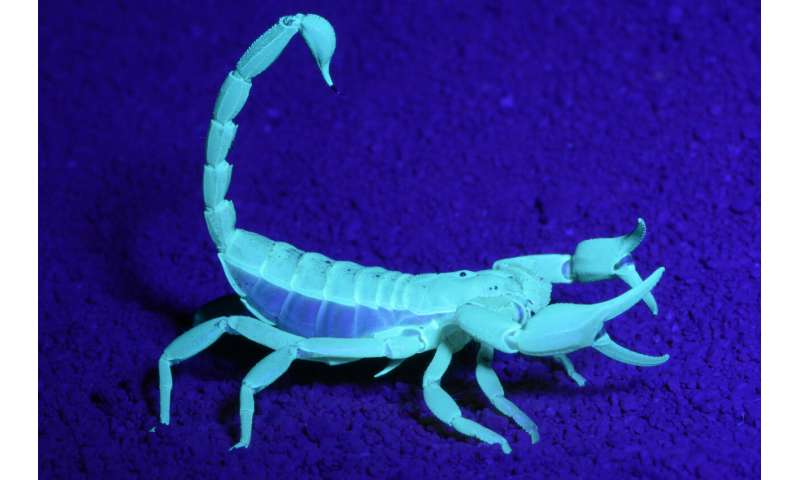Scorpions a clue to restoring ecosystems
by Science X staff
Researchers from La Trobe University have found that, in the absence of natural predators such as bilbies, native scorpions are thriving in Australia's damaged sandy landscape.
Lead researcher Heloise Gibb said Australia's scorpion population was like an ecological barometer.
"Were they always so abundant or might this plethora of scorpions be the result of wiping out other species from the ecosystem?"
European arrival in Australia resulted in large-scale loss of native mammal species, largely through predation by introduced cats and foxes.
Re-introducing threatened native mammals—particularly digging species such as the bilby—may be a crucial piece of the puzzle in restoring those damaged ecosystems.
"The Mallee in particular can seem extremely harsh and even lifeless in the heat of summer days, but it comes to life at night, with geckos, spiders, scorpions and many other nocturnal animals," Associate Professor Gibb said.
"Large native scorpions, up to 9 cm in length, are really abundant in the Mallee and they play a big role as predators of other, smaller, species. In the Australian Wildlife Conservancy's Scotia Sanctuary in western NSW, where we conducted our research, we find up to 600 scorpion burrows per hectare, pocking the landscape."
In research published in Ecology, Assoc. Professor Gibb's team found scorpion numbers plummet in the presence of native mammals, such as bilbies, which are a surprisingly important predator. The team's experiments mimicking soil disturbance by native mammals also led to scorpion population decrease. Further, mammals were associated with declines in another important group of predatory invertebrates (spiders), which are known to regulate insect populations.
"Reintroducing locally extinct digging mammals provides an opportunity to restore ecosystems, but it's hard to get right because we don't know what Australia's ecosystems were like 200 years ago. It's important to consider that reintroductions may also result in unexpected consequences for ecosystem structure. Over-predation on one species might lead to increases in others and these changes can cascade all the way through from predators to plants."
Professor Gibb and the team used UV-proof glasses and UV torches to hunt scorpions in the dark on the hottest nights of summer.
"You can't see much with UV-proof glasses at night. But scorpions fluoresce in the light of our UV torches—so all you can see is scorpions. We used tongs to pick them up by their tails for measurements, because these scorpions are big and nobody wants to be stung."
More information: Heloise Gibb et al. Experimental evidence for ecological cascades following threatened mammal reintroduction, Ecology (2020). DOI: 10.1002/ECY.3191
Journal information: Ecology
Provided by La Trobe University